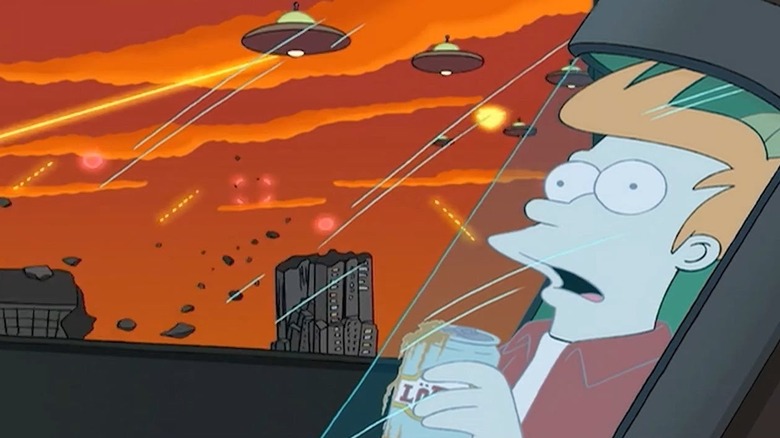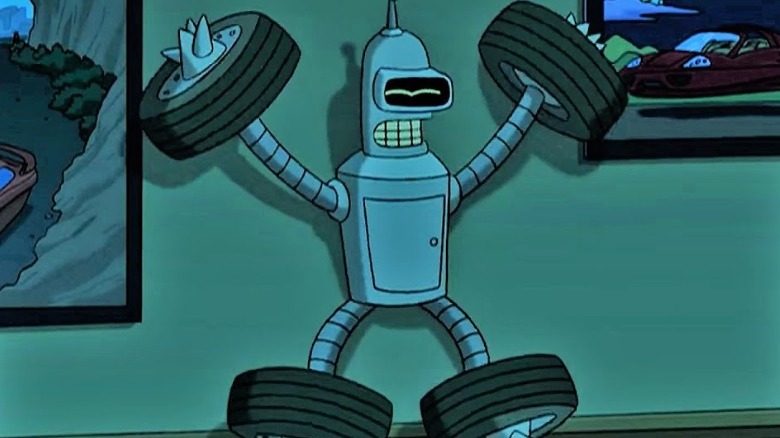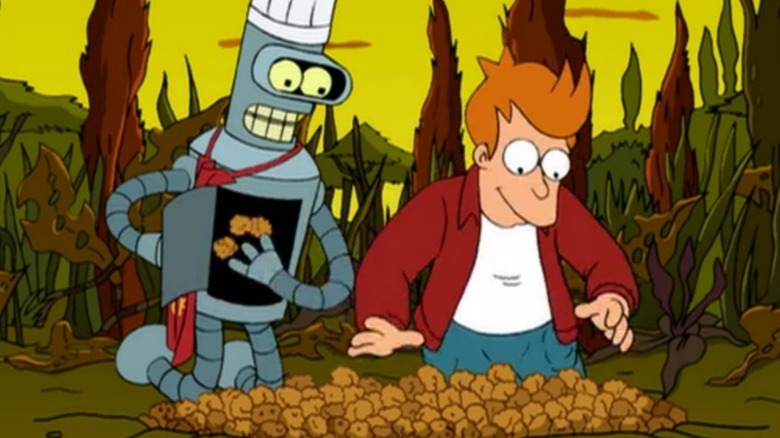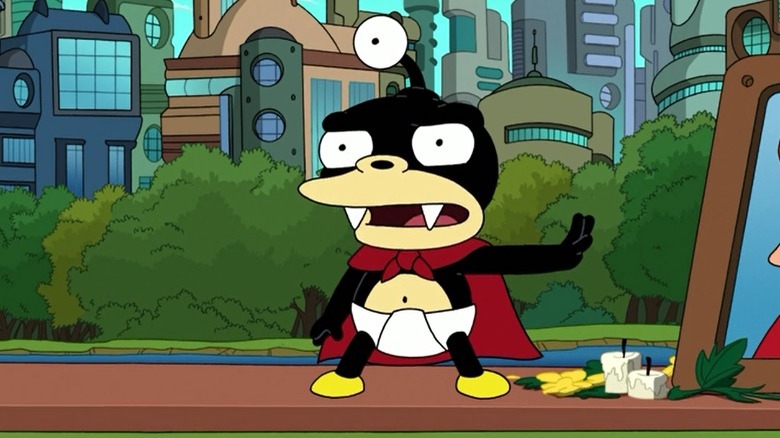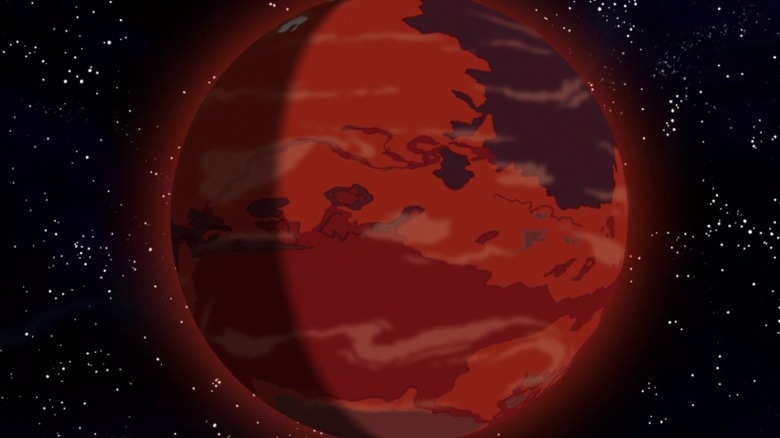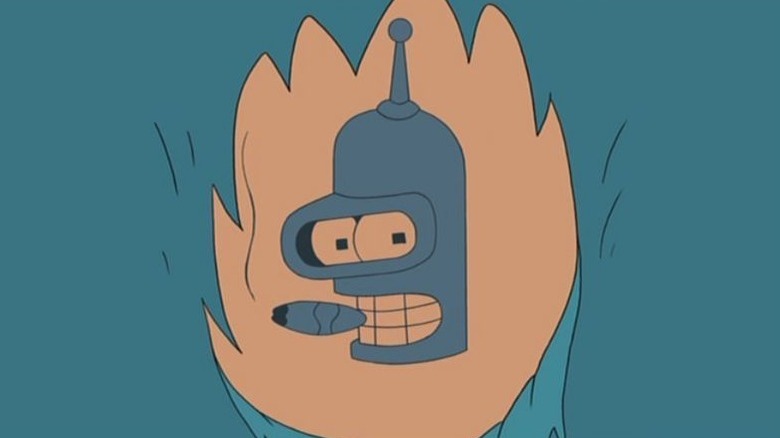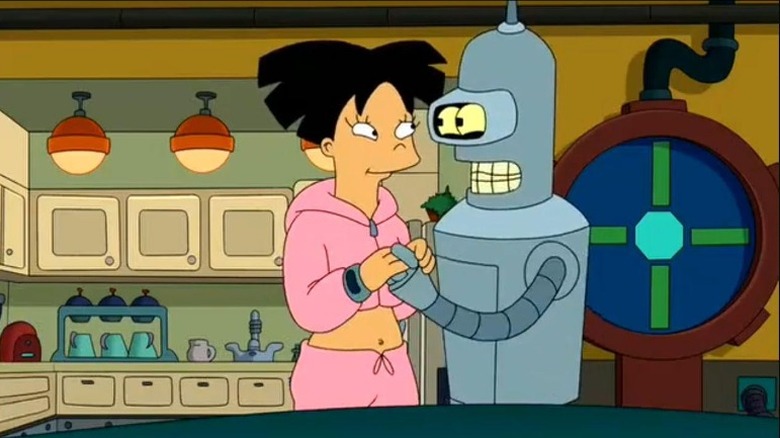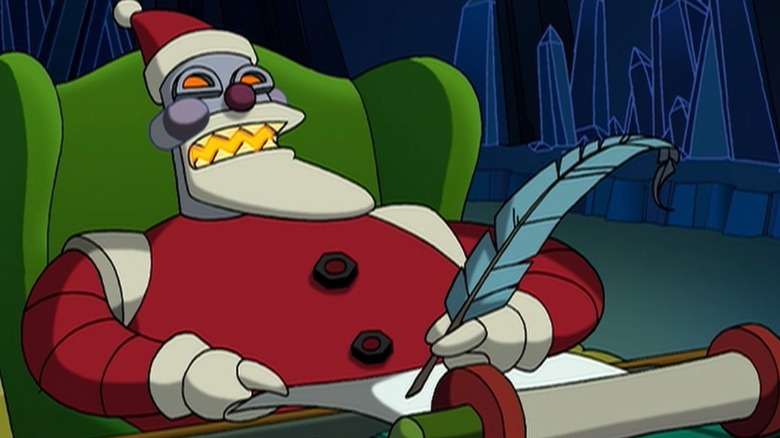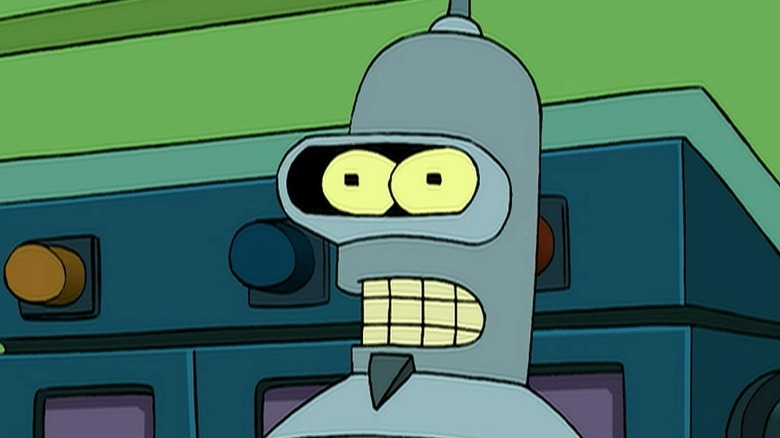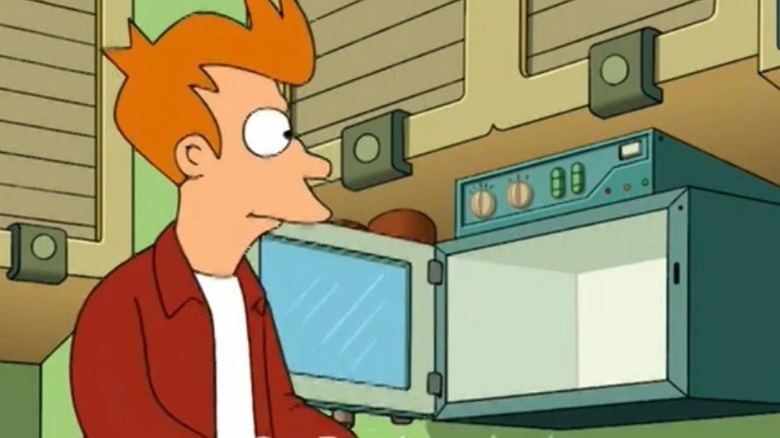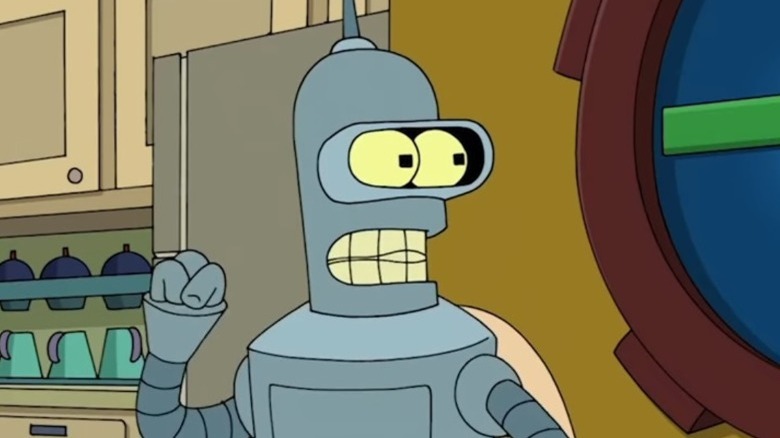The 12 Biggest Plot Holes In Futurama
Although it may not have had the longevity and success of Matt Groening's first animated series, "Futurama" proved to be successful in its own right. Launched in 1999 just in time for the turn of the new millennium, the show went on to win numerous Emmy Awards and is one of the best cartoons ever made, according to TV Guide.
As a sci-fi show set in the future, "Futurama" was never afraid to explore high-end concepts and difficult ideas. That made it endlessly interesting to watch — but it also created some rather problematic plot holes. After all, there are only so many times you can have stories featuring time travel, cloning, the destruction of the universe, and a literal robot devil before things start getting a little complicated.
While none of these plot holes ruined the show, they likely left viewers struggling to fully understand what was going on at times. Here are some of the biggest plot holes in "Futurama" history.
The Cryogenic lab somehow survives
The entire premise of "Futurama" is that Fry was frozen in an Applied Cryogenics' cryo-tube in the year 1999 for a thousand years when he fell backward while sitting on a chair. Regardless of whether such a technology would even be possible during Fry's lifetime, the facility somehow survives an entire millennium without suffering any issues or problems. This might seem unlikely, but there are even bigger problems when you consider some of the things shown in the series.
The first plot hole comes from the fact that New York is destroyed entirely twice but that the Applied Cryogenic lab is unaffected. In the opening episode, "Space Pilot 3000," when Fry is frozen, alien spacecraft can be seen in the background twice pulverizing all of the buildings. In "Bender's Big Score," it is revealed that at least the first of these events was actually caused by Bender himself while being pursued by the Swedish military after stealing valuable artwork.
"Futurama" has also established that Fry's version of the city, known as Old New York, actually lies in ruins in the sewers beneath New New York. Fry recognizes some of the buildings and neighborhoods when exploring the ruins in the first and subsequent episodes. In both cases, it seems impossible for the lab to have survived and remained above ground in New New York all that time.
Fry reinventing the wheel
The episode "Mother's Day" from the second season of "Futurama" sees Mom order her robotic creation to rebel against humanity and take over the world. Using the Universal Robot Controller, she intends to place herself in charge of Earth's population. As technology turns against the population, robots are quickly able to subjugate everyone and things look bleak until Mom's three sons, Walt, Larry, and Igner, work with the Planet Express crew to end the rebellion. Without the use of any modern devices and technology, though, the group has to rely on Fry's knowledge of 20th-century machinery to get around.
One of the ways that Fry helps the gang get around is by effectively reinventing the wheel, an object that nobody seems to be aware of. Even Professor Farnsworth has not heard of the wheel, suggesting that wheels are not commonplace in society and that they have been completely supplanted by modern technology. The problem is, wheels had already been shown in plenty of previous episodes of "Futurama," demonstrating that they are not simply some relic of the past but items that are still effective and useful in the future.
For example, the episode "The Honking" shows that the Were-Car and its victims have wheels, while "The Cryonic Woman" has wheeled vehicles that are used in post-apocalyptic car battles. All of this opens up questions about what really is the deal with wheels in the show and why people don't seem to know what they are.
Where is all the Poppler cash?
"The Problem with Popplers" is a Season 2 episode of "Futurama" that sees Fry, Leela, and Bender discover a new type of snack food that becomes wildly popular back on Earth. Known as Popplers, they are addictive and incredibly tasty, leading to massive sales. Unbeknownst to everybody, these tiny lifeforms are actually Omicronian children, a fact that prompts Lrrr and his alien forces to invade Earth and seek revenge for the death of billions of their children. They initially demand to eat as many humans as the number of Popplers consumed, but the 198 billion far exceeds humanity's population, so they instead decide to devour Leela.
One Redditor calculated that the 198 billion Popplers that were sold should have generated some $16.5 billion in sales for the Planet Express crew, as they were sold for a dollar a dozen. While that figure was before tax, it should still have meant a huge profit for the gang, especially when it was so easy to acquire the Popplers in the first place. Considering how run down the company is and how it just about manages to scrape by, that's a huge amount of money and could change the fortunes of everyone at Planet Express. Yet, there is no mention of the money and it seems like it just disappeared without a trace.
Nibbler leaves the universe and suddenly appears again
Nibbler may appear to be a cute and cuddly creature but he is actually a powerful figure from the ancient race known as the Nibblonians. At various points in the history of "Futurama," Nibbler has played a significant role in events. He was responsible for pushing Fry into the cryogenic tube in the year 2000, for example, and he battled the Brain Spawn in "The Day the Earth Stood Stupid" to finally end the war with the Nibblonians. Nibbler later played a big role in "Bender's Big Score," in which he tries to warn everyone about the dangers of time travel.
When it becomes clear that the paradoxes caused by Bender traveling through time have irreparably damaged the universe, causing numerous cracks in space, Nibbler attempts to escape. He swallows himself and disappears while forgetting to erase the memories of those around him, leaving them aware of just how intelligent he really is. After Yivo leaves the universe in "The Beast with a Billion Backs," Nibbler suddenly returns to the Planet Express building without any explanation of how he got there or where he's been during the intervening time.
Mars is still around after being destroyed
Following the cancellation of "Futurama," the creators behind the show were able to create four direct-to-DVD specials as part of a deal with Comedy Central. Eventually, this led to a revival on the network, with two additional seasons coming between 2010 and 2013. This particular plot hole deals with an issue brought up in the seventh and final season of the show (at the time of this writing in 2022) and focuses on the planet Mars.
The home planet of Amy Wong, Mars became habitable sometime before the events of "Futurama" and is home to the prestigious Mars University and Wong Ranch as well as the native Martians. During the events of "A Farewell to Arms," which is the second episode of Season 7, the planet is completely destroyed by a solar flare after the Planet Express crew discovers an ancient prophecy that foretells the end of Mars in 3012.
Yet, by the time of the 12th episode of the season, "Viva Mars Vegas," Mars is seemingly perfectly fine and no longer destroyed. In fact, the main characters visit the planet for a vacation and no explanation is given about what has happened in the time between the two episodes to magically fix Mars and put it back in its proper place.
Fry's tattoo of Bender
Time travel plotlines are always likely to cause plot holes in long-running TV shows. The ability of characters to go to the past and future opens up the possibility of paradoxes and problems that make it a minefield for writers to tackle. That hasn't stopped the team behind "Futurama" from exploring time travel multiple times, most famously in the movie "Bender's Big Score." This entry in the franchise sees the Planet Express crew and the scammers discover the time code hidden in a tattoo on Fry's bottom. Reading it allows Bender and others to travel back to any point in history.
"Bender's Big Score" actually deals with most paradoxes and other plot holes that are typical with time travel stories quite effectively, but there is still one issue. Near the end, Bender goes back in time one last time to place that tattoo he removed from Lars — who is really just an older Fry — on Fry in the year 1999. This creates a bootstrap paradox, otherwise known as a causal loop, because the source of the tattoo is Fry himself and it wouldn't have existed on Fry unless Bender put it there in the first place. That doesn't even take into account the fact that no one has ever seen or noticed the tattoo before, even Fry himself, so it is not known where it came from.
Seymour the dog searching for Fry
Seymour is Fry's faithful dog from the year 2000. The two quickly became fast friends when Fry discovered him living on the streets but he is left behind when Fry is frozen and awakens in the year 3000. The character then finds a fossilized Seymour in a museum in the episode "Jurassic Bark." He apparently lived for 12 years after Fry's disappearance. The truth is that the dog searched for his master during that time and obediently waited outside of Panucci's Pizza every day, waiting for Fry to return.
As has been noted on Reddit, this creates something of a plot hole with the film "Bender's Big Score," as this sees Fry travel back to the year 2000 and live with Seymour before eventually becoming the character viewers know as Lars. If these events really did happen, then it would have been impossible for the events shown in "Jurassic Bark" to also be true. After all, Seymour could not have had two completely different fates in the same universe and wouldn't have searched for Fry if he was actually living with him.
Humans dating robots
You might think that the year 3000 would mean that people would be more open-minded and sympathetic, but that's not always the case in "Futurama." In fact, many of the issues that people deal with today in real life are carried over to the futuristic setting of the animated series, despite the huge time difference. One of the most contentious issues is the idea of robots and humans having relationships — something that also throws up a major plot hole.
The Season 3 episode "I Dated a Robot" sees Fry date a robot that has the looks and personality of Lucy Liu. This causes controversy and revulsion among the rest of the Planet Express crew, who even show Fry a video that explains how civilization could be brought to an end if humans and robots start to date. It's clearly shown in this episode that this kind of relationship is certainly frowned upon in society.
Yet, this is not always the case. The Season 4 episode "The Devil's Hands Are Idle Playthings" follows the attempts of the Robot Devil to force Leela to marry him after Fry gets the better of him in a previous deal. Here, there's no taboo surrounding the idea. Later, in the Season 6 episode "Proposition Infinity," Bender and Amy begin a relationship that is frowned upon by most in society but the Planet Express crew is largely fine with it, despite their earlier revulsion over Fry and the Lucy Liu bot.
Why has Santa not been destroyed?
In the world of "Futurama," Robot Santa is a terrifying figure who was created 200 years ago. Meant to judge every person on the planet as either being naughty or nice, and then distribute presents accordingly, his standards were set far too strictly. This resulted in the entire population being deemed to be naughty and worthy of punishment. Each year, Robot Santa goes on a rampage across Earth, using Christmas-themed weapons to injure or kill those he comes across.
While Robot Santa is clearly a powerful figure (backed up by an army of elves stationed on Neptune), it seems illogical that the governments of Earth have not done anything about him since he was created in 2801. After all, he is just a single robot. The huge human military could make easy work of him, and the characters know where he lives outside of the festive period. They would not even have to necessarily kill him as they could instead capture him to fix his programming and make him work as intended. The fact that he has effectively been allowed to wreak havoc for two centuries without any sort of effort being made to stop him makes no sense.
Characters simply disappearing
"Futurama" is an animated show that has a huge cast of characters outside of the core group. They range from regular humans to aliens from the far reaches of space. There are even plenty of weird creatures and robots to throw into the mix, as well as the occasional mutant. Some of these individuals have even done some pretty terrible things, but there's one nagging problem with a few that have seemingly just disappeared without any explanation, never to be mentioned again.
Two of the most notable examples of this are Flexo and Guenter. The latter is first introduced in the episode "Mars University" as a hyper-intelligent monkey who is enrolled at the educational facility. There's one catch, though, in that his intelligence is completely dependent on his Electronium Hat — a device developed by Professor Farnsworth that creates cognitive radiation from the energy given out by sunspots. In total, he appears in four episodes of the series and the movie "Into the Wild Green Yonder," but he is not seen after "Fry and Leela's Big Fling."
Meanwhile, Flexo is a robot that looks very similar to Bender but with a goatee. He was last seen in the Season 6 episode "Attack of the Killer App," when it is revealed that bending units like Flexo and Bender are outdated and scheduled to be destroyed. His exact fate is never shown after he appears in a dumpster. However, "Lethal Inspection" suggests that these types of robots cannot be killed, leaving questions about Flexo's whereabouts and fate.
Everyone uses outdated technology
Because the show is set in the year 3000, "Futurama" has plenty of advanced technology that is not available today. There are flying spaceships that can travel through space at impressive speeds, robots that carry out many of the tasks that humans don't want to do, and famous figures can have their heads preserved in jars so they can effectively live forever. There's a lot to admire about the future depicted in the show (in fact, "Futurama" has freakishly predicted the future on several occasions), and it shouldn't be all that surprising that there's been a lot of progress in the thousand years between now and then. However, things haven't advanced quite as far as they probably should have.
A phone box is shown in "Into the Wild Green Yonder," while cellphones are common throughout various episodes of the series. The first season episode "A Big Piece of Garbage" mentions a CD player and Fry can be seen cooking food in a microwave in "Roswell That Ends Well." Computer screens appear to be very basic and significantly less modern than what people have access to today, as noted by Slate. Meanwhile, newspapers often contain visual gags but why newspapers are even still around is never fully revealed. In fact, there's little information on why so much outdated and retro technology still exists in the world of "Futurama."
What is Bender actually made of?
Voiced by John DiMaggio, Bender is an alcoholic robot who acts as Fry's best friend and works with the rest of the Planet Express crew. Despite expressing a desire to kill all humans, the belligerent character has a sweet and soft side that very few people get to see. He also has exceptional strength and is powered by drinking alcohol of all kinds, converting the ethanol into electrical energy, though he also seemingly has a nuclear reactor somewhere in his body. All of this begs the question: What is Bender actually made of?
Bender's composition has never been fully explained in "Futurama," although the character has made some claims himself over various episodes as a sort of running gag. In "Fry and the Slurm Factory," he stated he was made up of 40% zinc. In "A Head in the Polls," he said he was 40% titanium. And in "The 30% Iron Chef," he claimed to be — you guessed it — 30% iron. At other points, Bender has said he's made of 40% of elements such as lead, dolomite, nickel, wire, and horseshoes. Of course, adding all of these different materials together makes for an impossibly large percentage.

